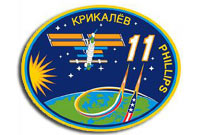NASA Space Station Status Report 16 September 2005

The installation of a replacement part for an oxygen-generating system, unpacking a recently arrived cargo carrier and the disassembly of a radiation-detection experiment highlighted this week?s activities aboard the International Space Station.
Expedition 11 Commander Sergei Krikalev and NASA Science Officer John Phillips are scheduled to activate the Elektron oxygen-generation system with its new liquids unit on Monday. The Elektron breaks down water into oxygen for use in the station’s atmosphere. The Elektron has not functioned for several months. Adequate oxygen supplies are available on the station from tanks and Solid Fuel Oxygen Generators.
The new liquids unit arrived aboard the ISS Progress 19 cargo craft, which docked to the complex at 9:42 a.m. CDT Saturday. The Progress craft brought 2.6 tons of cargo to the station. Krikalev and Phillips began unloading the cargo on Sunday.
The Progress brought more than 2,700 pounds of dry cargo to the station, including food, equipment, supplies, clothing and components of scientific experiments. The rest of the cargo included fuel for the station’s thrusters, water and oxygen. Unloading continued intermittently through the week.
After a light-duty day Monday, the crew transferred Progress cargo and entered the items into the station’s computerized, bar-coded inventory management system on Tuesday. Much of Wednesday was devoted to disassembly of the Matroshka radiation experiment, retrieved from the exterior of the station during an August spacewalk, for return to Earth.
A major part of the European Space Agency Matroshka experiment, developed and built in Germany and operated through the German Space Agency’s Microgravity User Support Center in Cologne, is a human-torso-like device. It was launched on a Progress in January 2004 and installed on the outside of the Zvezda Service Module the following month.
Its interior is similar in density to a human’s, and 20 radiation detectors are mounted in positions of major human organs. Other detectors inside the station also gathered data for transmission to Earth and station computers. The experiment is designed to better understand the exposure of astronauts, including those making spacewalks, to radiation.
In addition to the Elektron liquids unit replacement, Thursday work included setup of hardware for the Foot/Ground Reaction Forces During Spaceflight (Foot) experiment. Phillips put on customized Lycra cycling tights for his fifth and final session of the experiment. Foot investigates the differences between use of the body’s lower extremities on Earth and in space, as well as changes in the musculoskeletal system during spaceflight.
During the session, Phillips wore the instrumented Lower Extremity Monitoring Suit, or LEMS, which measures joint angles, muscle activity and forces on the feet while exercising. During the final run, a special exercise protocol was used to measure forces Phillips experiences on the cycle ergometer and the Resistive Exercise Device.
Taking force measurements while running through the range of settings with each piece of exercise equipment helps determine the settings necessary to match the forces that bones experience during exercise on Earth. Matching those forces during exercise is critical to reducing the amount of bone lost while in weightlessness.
Also this week, flight controllers and engineers in Houston assisted with the transition aboard the station to a faster advanced portable computer software. The transition was completed Wednesday. Flight controllers also maneuvered station cameras to capture images of Hurricane Ophelia several times this week as it approached the Carolina coast.
For information on the crew’s activities aboard the station, future launch dates, and station sighting opportunities from anywhere on the Earth, visit:
The next station status report will be issued on Thursday, Sept. 22, or earlier if events warrant.








